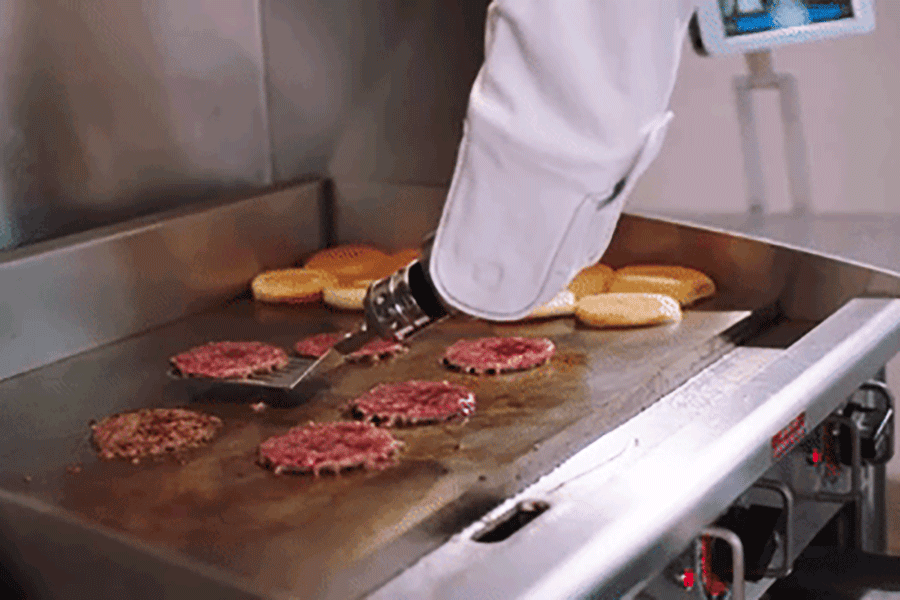On March 2018, Flippy an AI-powered robotic arm started its shift at a CaliBurger joint and flipped the first burger, giving a glimpse of the future to the 3 million people in the United States that works as fast food cooks and food preparation workers. Today, it serves as an AI-powered kitchen assistant in several CaliBurger restaurants.

We are witnessing a fundamental transformation in the way we work. With Artificial Intelligence (AI) and robotics becoming the norm, many scientists discuss the potentials of new technologies to substitute for human labour.
A study by McKinsey & Company found that about 30% of tasks in 60% of occupations could be computerized. It doesn’t matter whether you’re a factory worker, a radiologist, or a professional artist – automation is coming for you.
Of course, not all jobs are impacted equally. In 2013, a very famous study by Oxford University academics called The Future of Employment examined 702 common occupations and found that some jobs – telemarketers, tax preparers, and umpires – are at more risk than others.
Routine jobs like Telemarketing has a 99% probability of automation, while fast-food cooks, which face an 81% probability. While these are low median income jobs, here’s a list of some high paying professions that are considered lucrative today, which probably won’t exist in future.
Portfolio Managers
A survey from Aite Group –a research firm evaluated that businesses have started investing in automated portfolios. The investment rate increased to 270% in 2019. Many recent reports by market analysts found that robo-advisors have taken over already in some giant corporations. Wall Street is just one of the examples that have replaced hundreds of its financial analysts with robo-advisors and high-tech software.
Oxford academics in its 2013’s paper claims that approximately 74% of professions are at high risk of becoming automated in the next 10 to 20 years; an alarming 54% of jobs among them will be in the finance industry.
Radiologists
Radiologists have typically had a pretty sweet deal in the health care sector. They make, on average, around $400,000 a year — nearly double what a family doctor makes — and often have less working hours.
Radiology, at its core, is now a human being, based on learning from experience, looking at a collection of digital dots and a digital pattern and saying ‘That pattern looks like cancer or looks like tuberculosis or looks like pneumonia’ and guess what is awfully good at seeing patterns? Computers.
Click here to see the level of risk they are in and the money they’ll lose out on.
Pilots
The idea of planes being flown by machines might scare some people, but it is actually very likely that you’ve already been onboard an auto-piloted flight. Modern commercial aircraft respond to flight plans, which are inputted by the pilot. It then analyses and implements the best way to reach the destination.
It will be surprising to know that Asian flight carriers forbid their pilots from landing the plane, insisting the process must be automated.
The number of crew members has already reduced from 3 to 2; it is likely that by 2030 only one supervising officer will be required to man the cockpit.
( See the job risk and salaries for pilots).
Credit Analysts
Another fancy profession which pays around 81,160 per annum stands a chance of 98% automation. As artificial intelligence continues to advance, new software will be able to tackle more and more complex tasks.
Consider Australian start-up Hyper Anna: it offers a virtual “data scientist” tool for financial services companies that provides analysis on revenue forecasting, supply chain management, and similar processes. Hyper Anna can even write code and provide sophisticated reports, charts, and insights from basic data.
A study by The Boston Consulting Group and the China Development Research Foundation showed that artificial intelligence would eliminate 390,000 jobs in financial support functions by 2027, but that it would improve efficiency of the surviving jobs by 45%.
What does this mean for you?
The pace of change is accelerating. Competition for the right talent is fierce. And ‘talent’ no longer means the same as what it meant years ago; many of the roles, skills, and job titles of tomorrow are unknown to us today.
How can organizations prepare for an uncertain future? How will you up-skill yourself without having known what is required?
At 6figr.com, we try to quantify what is a person’s realistic potential lift of pay and employability score. Essentially, it tells you the next best step based on what you have done to date. You can use the Career Dashboard to find out where you stand in your career and then make informed career decisions

This isn’t a time to sit back and wait for events to unfold. To be prepared for the future you have to understand it and you ought to do that with data.